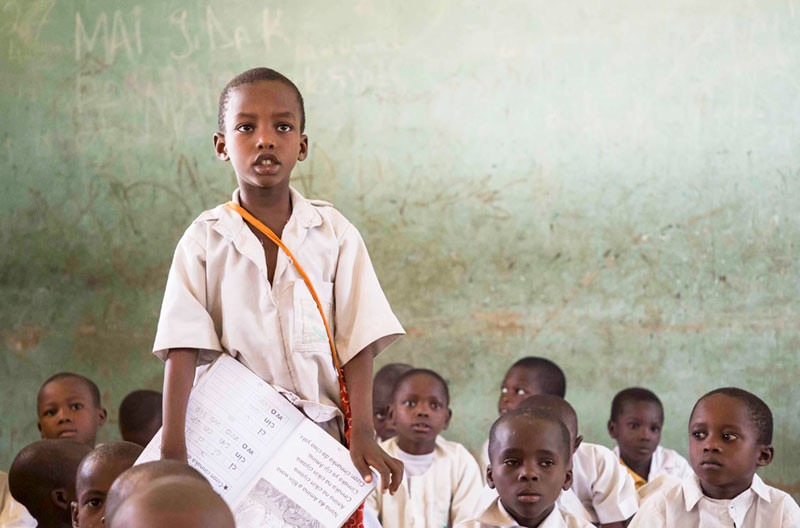During the past five years, the global growth of the number of children in classrooms has been stagnant, according to recently published UNESCO Institute for Statistics data.
Sobre 263 million children—one in five children— adolescents and youth worldwide are out of school, the U.N. agency reported. Desde 2012, the number of school-aged children and youth in classrooms around the world has increased by only about 1 milhão a year.
“These new figures show starkly the size of the gap that needs to be closed to ensure universal access to education,” said UNESCO Director General Audrey Azoulay in a Comunicado de imprensa. “We need much more comprehensive and targeted approaches together with more resources to reach those children and youth who are denied the right to education, with a special emphasis on girls and on improving the quality of education for all.”
Sub-Saharan Africa remains the region with the highest out-of-school rates for all age groups, and accounts for more than half (34 milhão) do 63 million out-of-school children of primary age, de acordo com o relatório.
Countries with the highest out-of-school rates also tend to be among the poorest countries in the world. Poverty levels are also closely linked to gender disparities in education.
O UNESCO data stresses that a business-as-usual approach will not succeed in achieving universal primary and secondary education by 2030.

Ensuring education amid crisis
This call for new approaches is particularly critical given the swelling rates of displaced persons and refugees across the globe, including millions of school-aged children and youth, points out Eileen St.. Jorge, Diretor de Educação em Conflito na Creative, who read the published report.
For these out-of-school children and youth, gaps in education can be compounded by the trauma of conflict and displacement. Years out of school can set learners back in literacy and life skills; unhealed trauma can negatively affect their life outcomes.
“To keep children and youth in the classroom – especially in conflict and crisis environments – we need increasingly innovative approaches to minimize disruption to learning,”diz São. Jorge, adicionando isso non-formal community-based learning centers can help to provide basic education to displaced learners when formal schools are not an option.
Regardless of the forum for education, a sense of normalcy and security is particularly critical to the development of these vulnerable learners, she adds.
“It is essential for schools to create a safe environment for students to receive a quality education and to heal through psychosocial support and Social Emotional Learning,”ela diz.
In conflict-affected countries like Afeganistão e Nigéria, Creative is implementing multiple education projects that integrate Social Emotional Learning activities into their curriculum.
“By providing Aprendizagem sócio-emocional support in the classroom, educators in complex settings like Nigeria and Afghanistan, can create a powerful learning environment that fosters healing, apoiar, motivation and ultimately success of vulnerable children and youth,”diz São. Jorge. "No entanto, to achieve this we must also turn our attention to the well-being of teachers, enabling them to effectively nurture the children and youth in their classrooms.”
Empowering girls through education
UNESCO also finds that around the world, girls continue to face barriers in receiving an education.
O UNESCO figures show that in sub-Saharan Africa, girls of every school-age group are more likely to be excluded from education than boys. For every 100 boys of primary age out of school, há 123 girls denied the right to education.
Traditional attitudes and cultural beliefs, pobreza, early marriage and pregnancy and violence against women and girls, are among the many barriers that keep girls from accessing quality education.
Karen Tietjen, Diretor de Sistemas Instrucionais e Governança na Creative, points to the USAID Leia para ter sucesso project’s “whole school, professor inteiro, whole learner” approach as an example of an effective way to counter school dropouts – especially for vulnerable girls.
"Criança inteira do Creative, professor inteiro, escola inteira, abordagem de sistema inteiro ”aborda fatores críticos de oferta e demanda que afetam o aprendizado, ensino, gerenciamento, participação dos pais e capacidade de resposta às necessidades das crianças.
“When girls stop going to school because of household responsibilities, early pregnancy or other barriers, they are closing the door to a brighter future,”ela diz. “The Read to Success project in Zâmbia provided psychosocial tools and counseling support needed to help learners succeed in school and in life.”
Tietjen says the education project trained guidance and counseling teachers who also mobilized a cadre of energetic and effective youth allies to help support vulnerable students.
Chamado Agentes de Mudança, these groups of adolescents worked side by side guidance and counseling teachers to deliver important messages to their fellow classmates about staying in school, practicing healthy behaviors and making smart choices.
“With a support system, we witnessed vulnerable Zambian girls staying in school despite dealing with social, economic and psychological challenges outside of the classroom,”diz Tietjen.
“When girls have the opportunity to access quality education, they are empowered to gain the knowledge and skills needed to help break the cycle of poverty for themselves, their families and communities,”ela diz.



